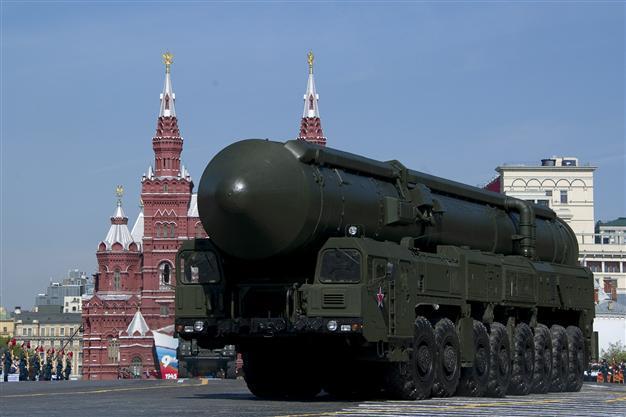Russia tests new missile after NATO summit
MOSCOW - Agence France-Presse

AFP photo
Russia today staged the first successful test-launch of a new intercontinental missile designed to penetrate the defense system now being deployed by NATO despite Moscow's fierce complaints.The highly-symbolic launch came just days after alliance formally activated the first stage of a missile defense shield whose deployment Russia has bitterly opposed out of fears that it may target its own vast nuclear arsenal.
"The dummy warhead reached its target area at the Kura test range on the Kamchatka Peninsula. The set goals of the launch were reached," Interfax quoted Russian Strategic Nuclear Forces spokesman Vadim Koval as saying.
A military source told the agency that the launch was only the second ever conducted in the top-secret program.
The source said the first failed on Sep. 27 when the missile suffered an undisclosed malfunction and crashed only 10 kilometers from the launch site.
The rocket still has no formal name but is being billed by the military as a "fifth generation" weapon that substantially upgrades the technology used by its already-feared feared Topol-M and Yars systems.
Various sources told Interfax that the new missile was better equipped to penetrate the new U.S.-backed missile defence system in Europe whose first stage NATO official activated at its Chicago summit on Sunday.
"This is one of the ... measures being developed by Russia's military and political leadership in response to the U.S. deployment of a global anti-missile system," former strategic forces director Viktor Yesin told Interfax.
Little is known about the new weapon except its purported ability to better avoid being shot down.
The Russian missile "uses a new type of fuel that helps reduce the time required to operate the propellants in the active stage of the rocket's trajectory," one military source said.
Officials believe this makes it more difficult to detect and easier to manoeuvre. Interfax said the weapon is also equipped with individual warheads that can change course to avoid being shot down.
Russia has hundreds of missiles capable of raining down nearly 2,000 nuclear warheads on the United States and its other former Cold War-era foes.
But much of the force is built on technology developed in the Soviet era that Russia fears may become obsolete by the time NATO's shield becomes fully operational by the scheduled date of 2018.
Russian President Vladimir Putin unveiled a massive new armaments program during his successful election to a third term and made a visit to a military factory one of his first high-profile stops after his May 7 swearing in.
Putin's predecessor and protege Dmitry Medvedev warned the West last year that Russia will have to deploy new rockets on the borders of NATO's European partners such as Poland should its concerns not be addressed.
The army's top general Nikolai Makarov this month also warned the United States that Russia reserved the right to preemptively strike NATO targets once it feels its shield posed a significant threat.
U.S. President Barack Obama has sent multiple negotiating missions to Moscow and was earlier this year caught by an open microphone telling Medvedev that he intended to negotiate more on the issue should he win re-election in November.
The Russian military forces spokesman said the missile was launched from a mobile system at the northern Plesetsk space base at 10:15 am (0615) GMT on its 6,000-kilometers journey to the Pacific.
News reports did not specify the missile's actual range nor the number of warheads it can carry.
















